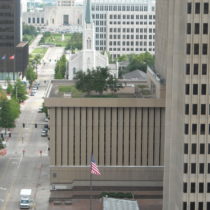Landscape Architecture for Landscape Architects › Forums › SUSTAINABILITY & DESIGN › Developing a Strong Design Concept
- This topic has 1 reply, 6 voices, and was last updated 15 years, 3 months ago by
 Frank Varro.
Frank Varro.
-
AuthorPosts
-
August 31, 2010 at 3:10 am #168025
 Samuel Burnett-RagueneauParticipant
Samuel Burnett-RagueneauParticipantI would really love to hear about peoples process of developing and implementing Strong Design Concepts in their own work.
I am really interested in hearing about individuals or firms personal process.
This is a topic of immense interest to me as I see it as not only the most exciting aspect of our work but also one of the most important in developing meaningful and successful places.
Although I often look for good information on this topic I am generally disappointed and always left looking for more.
I look forward to your responces!
August 31, 2010 at 3:23 am #168030 Frank VarroParticipant
Frank VarroParticipantOne of the most important things I learned in Grad School was to always to design like you are working on a competition. A competition seems to give free reign to move forward with crazy, over-the-top design ideas. You can always take an un-build-able design idea and make it do-able, while maintaining the big idea.
Taking a lame, small idea, and trying to infuse it with deep meaning? Good luck. Go big, then you can worry about getting it built. That’s what conceptual design is for.
August 31, 2010 at 5:28 am #168029 ncaParticipant
ncaParticipantMy long reply went poof, maybe for the better.
Tough question and I’m curious to read what others write.
I’m not sure I could really define a single formula I follow–Sometimes the concept just reveals itself and sometimes its a battle and the only thing I can do is walk away and avoid the problem for a couple weeks.
I agree that it’s good to start with big ideas. I know people who like to start by thinking about the number of parking stalls we need or where the bike racks go. I also think it is possible to start with little ideas that grow into long narratives. I’ve found that a lot of ‘more experienced’ designers consider ‘good design’ knowing how big things are. Ugh. So overall I agree with Frank.
Personally, I’ve found a lot more inspiration in nature than in cities, even when I’m working on urban projects. My process almost always includes a healthy dose of hand sketching, writing, noting, listing, scribbling, reading, and starting over.
A couple of things that have become ingrained in my mind over th epast few years are as follows (and in no way are these ‘rules’, but just little reminders I seem to repeat to myself:
1. finish the idea before trying the next one. One of our professors preached this and I’ve found it very useful. Often times the last failed concept informs a part of the next, which informs the next, until I get there or have a million examples of things I DONT want to do,lol.
2. Think with your hands. I try to keep drawing, sketching, writing, etc while I’m ‘just thinking.’ Sometimes ideas happen by accident.
3. ‘The secret to creativity id knowing how to hide your sources’ -Einstein. I try not to be afraid to look at what has been done or find examples in nature and let that inform the application of my own ideas.
I’m sure someone has a list of seven rules to good design or something. I think the process changes and is almost never the same on any given project. I find that at times when I really struggle to design is when I’m trying to design, if that makes any sense. When I let myself have fun I find that ideas flow more freely and naturally. Sometimes I’ll catch myself trying to do a ‘Peter Walker’ or a ‘Schwartz’ and forget that I don’t really even like their work, lol.
August 31, 2010 at 2:44 pm #168028 Thomas J. JohnsonParticipant
Thomas J. JohnsonParticipantI believe that there is an underlying geometry to the world. The way that circles, squares, triangles, etc. interact is preordained. If I can achieve those relationships in a design, it will be beautiful at it’s core, materials and products become icing on the cake.
It also helps being a bit ADD and a design sponge. I read a lot, I observe a lot… all of those things float around in my head, my scrabbled brain pulls inspiration from here and there. Seemingly unrelated relationships gel and become something new….
The ability to “be” in your design also helps. Can you shrink yourself down and experience a plan in perspective? Walk around in it. What will it feel like to be there? During this process, I sometimes talk to myself, which must seem crazy to those observing me but it helps me tell the story of what’s happening. “I’m walking between these two columns, there’s a corridor with giant pots that create a rhythm, at the end of the corridor is…” Ask yourself questions about the areas you don’t know or that you can’t “see”. “What happens here…” If you can be there, see it, then you know what it will feel like and what the experience, form, plants/materials should be.
“Seeing” is key…
September 1, 2010 at 6:02 am #168027 Jason T. RadiceParticipant
Jason T. RadiceParticipantI tend to respond to the site and surroundong context. Lot shape, topo, regulating lines, and traffic flow. Certain situations require certain solutions, and you get to know that from experience. I also rely heavily on environmental psychology techniques to design patterns and spaces for heavy pedestrian areas. Because I deal mainly with sites with buildings on them, the archietcture also weighs VERY heavily in my designs with shapes and materials.
September 2, 2010 at 1:48 am #168026 Richard LongmanParticipant
Richard LongmanParticipantHad a history professor who paraphrased Daniel Burnham:
Think no small thoughts for they stir no man’s soul.
-
AuthorPosts
- You must be logged in to reply to this topic.


